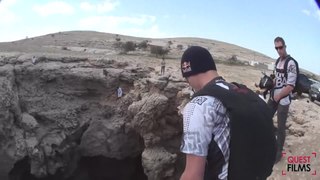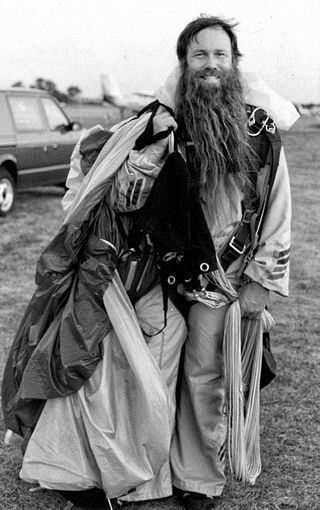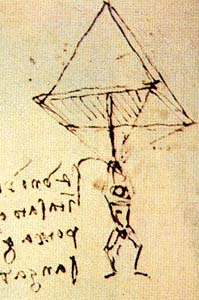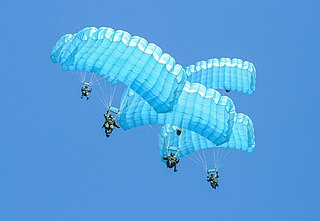
BASE jumping is the recreational sport of jumping from fixed objects, using a parachute to descend safely to the ground. "BASE" is an acronym that stands for four categories of fixed objects from which one can jump: buildings, antennae, spans (bridges), and earth (cliffs). Participants exit from a fixed object such as a cliff, and after an optional freefall delay, deploy a parachute to slow their descent and land. A popular form of BASE jumping is wingsuit BASE jumping.

A parachute is a device used to slow the motion of an object through an atmosphere by creating drag or, in a ram-air parachute, aerodynamic lift. A major application is to support people, for recreation or as a safety device for aviators, who can exit from an aircraft at height and descend safely to earth.
Cyprus is an island country in West Asia, geopolitically a part of Southern Europe, in the east Mediterranean, officially known as the Republic of Cyprus.

The 3-ring release system is a parachute component that is widely used by sport skydivers and military freefall parachutists to attach the two risers of a main parachute to the harness that bears the load under the parachute.

Bill Booth is an American engineer, inventor, and entrepreneur in the skydiving equipment manufacturing industry. His invention of the 3-ring release safety device has enhanced skydiving safety. He founded the companies United Parachute Technologies and Complete Parachute Solutions, which had 150 employees as of 2015.

In skydiving, an automatic activation device (AAD) is a dead man's switch consisting of an electronic-pyrotechnic or mechanical device that automatically opens the main or reserve parachute container at a preset altitude or after a preset time.

A malfunction is a partial or total failure of a parachuting device to operate as intended. Malfunctions may require a skydiver to cut away their main parachute and deploy the reserve parachute.

A static line is a fixed cord attached to a large, stable object. It is used to open parachutes automatically for paratroopers and novice parachutists.

Tandem skydiving or tandem parachuting refers to a type of skydiving where a student skydiver is connected to an instructor via a harness. The instructor guides the student through the whole jump from exit through freefall, piloting the canopy, and landing. The student needs only minimal instruction before making a tandem jump with the instructor. In the United States most skydiving centers and clubs require that participants be 18 years or older to skydive whereas in other countries the minimum age can be lower or higher. This is one of three commonly used training methods for beginning skydivers; the others being Static line, Instructor-assisted deployment (IAD), and Accelerated freefall (AFF) (k).
Cut-away is a skydiving term referring to disconnecting the main parachute from the harness-container in case of a malfunction in preparation for opening the reserve parachute. The 3-ring release system on parachutes allows a rapid cut-away in the event of an emergency.

A reserve static line, occasionally called a Stevens Lanyard or Stevens Release, is a device that automatically opens the reserve parachute container when the main parachute is cut-away. The RSL is a lanyard connecting one or both of the main parachute risers to the reserve ripcord.

Accelerated freefall (AFF) (known in Canada as progressive freefall, and in Finland as Nova (NOpeutettu VApaapudotus, a literal translation)) is a method of skydiving training. This method of skydiving training is called "accelerated" because the progression is the fastest way to experience solo freefall, normally from 10,000 to 15,000 feet above ground level (AGL). In static line progression, more jumps are required to experience freefall, but the jumps are less expensive for the student as one instructor can dispatch multiple students per load and students are initially dispatched from lower altitudes. Under accelerated freefall, one or sometimes two instructors are dedicated just to one student.

The Canadian Sport Parachuting Association (CSPA), through affiliation with the Aero Club of Canada (ACC), is Canada's representative to the Fédération Aéronautique Internationale (FAI) and the International Parachuting Commission (IPC). Thus, the CSPA is the official sport organization for sport parachuting in Canada.

In a diesel engine, a glow plug is a heating device used to aid starting of the engine in cold weather. This device is a pencil-shaped piece of metal with an electric heating element at the tip.

Adrian Nicholas was a British skydiver who completed more than 8,000 jumps in 30 countries.

Parachuting and skydiving is a method of transiting from a high point in an atmosphere to the ground or ocean surface with the aid of gravity, involving the control of speed during the descent using a parachute or parachutes.
Parachute School of Toronto was a Canadian Sport Parachuting Association affiliated parachuting centre and skydiving drop zone operating from the Baldwin_Airport in Georgina,_Ontario.

The RA-1 Military Free-Fall Advanced Ram-Air Parachute System provides a multi-mission, high-altitude parachute delivery system that allows personnel to exit at altitudes between 3,500 feet and 35,000 feet. The parachute, which replaces the current MC-4 parachute, supports a total jumper weight of 450 pounds. It also provides non-MFF personnel with a ram-air parachute that is static-line deployed.
Firebird USA LLC is an American parachute manufacturer based in Eloy, Arizona. The company also has locations in Germany, Sri Lanka, and the Czech Republic, and was formerly based in Füssen and Bitburg, Germany. The company specializes in the design and manufacture of parachutes and at one time also constructed paragliders and parafoil kites.
A main assisted reserve deployment (MARD) system is a skydiving safety device for parachute systems. While there are many variations, the operation and intended outcome for each is the same: open the reserve parachute container and extract the reserve parachute's deployment bag using the jettisoned main canopy. A MARD builds upon how a reserve static line (RSL) safety device works and in most circumstances, MARDs incorporate an RSL.















